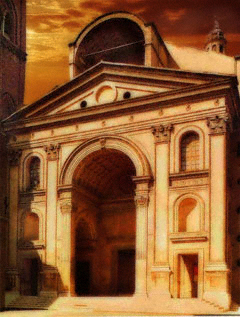

Maurizio Cazzati (1616-1678) was an Italian composer who wrote sacred and secular music. He was maestro di cappella of churches and courts such as S Andrea, Mantua; the court of Scipione Gonzaga, Prince of Bozzolo; the Accademia della Morte at Ferrara; S Maria Maggiore, Bergamo; S Petronio, Bologna; the court of the Duchess Anna Isabella Gonzaga at Mantua, and the Mantua Cathedral. Cazatti published 66 volumes of music during his lifetime, and although most of his works were sacred, he was noted for his contributions to instrumental music. [19]
Some scholars have asserted that the violin played an important role in the resurgence of the Mass in the 17th century, and composers such as Cazatti helped this occur. As described earlier in the Medieval musical period study unit, as a musical form, a Mass is a sacred vocal form of music used as part of the worship services for the Catholic Church. During the 17th century, the prominent use of violins in Masses primarily took place in messa concertata, Masses composed for festive ceremonial occasions. Music scholar Anne Schnoebelen described the violin's contribution to the revitalization of the Mass:
The violin was the favoured instrument of the ceremonial mass by the 1630s. Its role changed from providing extra-liturgical canzonas and sonatas to being incorporated into the fabric and form of the mass…The addition of violins was a turning point in the development of the mass, revitalizing it into a form that would attract composers for the next 250 years. [20]
TECHNIQUE TIPS: The excerpt chosen for this piece is taken from Cazzati's Kyrie, one of the sections in his Messa a 4 con violini, e ripieni a beneplacito, Opera XIV, published in 1653. This music may be categorized as a messa concertata, a festive ceremonial Mass used for special occasions such as liturgical feasts. As the title of the selected piece indicates, violins were specifically called for to perform this work. Although Cazzati's Kyrie is also written for voice, organ and violone (a large, bowed bass instrument), this arrangement features the melody from all parts. While playing the music, listen for Cazzati's ritornello sections. In Baroque music, a ritornello section is a recurring passage of music which is used in between new sections of music. At times, Cazzati reworks motives from preceding sections; at other times, he introduces new thematic material. Cazzati's instrumental music in this piece sounds like spirited dance music, and you may want to use sprightly, lively bowing to play this arrangement of Cazzati's Kyrie. Also notice how the meter shifts from 3/4 at the beginning, to 4/4 at measure 19.
© Copyright 2025 RK Deverich. All rights reserved.
Although this online viola class is provided free of charge, all rights are reserved and this content is protected by international copyright law. It is illegal to copy, post or publish this content in any form, and displaying any of this material on other websites, blogs or feeds is prohibited. Permission is given for individual users to print pages and perform music from this website for their personal, noncommercial use.